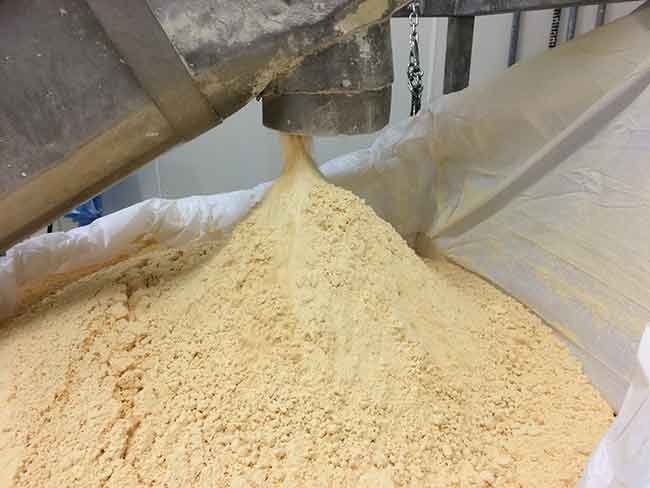
Value-added waste
By Treena Hein
Features Companies Compost Equipment Profiles Energy Manure Application/Handling SustainabilityPerth County Ingredients wins Ontario Premier’s Award for its conversion of egg processing waste to high-protein powder.
 Perth County Ingredients has developed a process to convert raw materials to a high-protein powdered ingredient used in animal feed and pet food manufacturing.
Perth County Ingredients has developed a process to convert raw materials to a high-protein powdered ingredient used in animal feed and pet food manufacturing.
As is the case in so many sectors, egg processing leaves material behind that ends up in the landfill site. But what if the inedible egg leftovers (called slurry or spinnings) could themselves be processed into something valuable? That’s exactly what Perth County Ingredients (PCI) of St. Mary’s, Ont., has accomplished, through upgrading a processing facility and working for a year to work out processing bugs.
Raw materials from local farms, grading stations and egg processors is converted into a high-protein powdered ingredient used in animal feed and pet food manufacturing. “Currently, the demand is very high for this product for the pet food industry and new opportunities are opening up for the future,” says Austin Currah, PCI’s plant and sales manager. “Right now, this product is shipped all over Canada and we have some current interest from Australia and Japan.”
It was 1952 when PCI’s parent company, Vanderpol’s Eggs Limited, decided to get into egg processing. Vanderpol’s established the Perth County plant in St. Mary’s in 1984, where workers use advanced processing and drying technologies to make dried, liquid and frozen egg products. These include standard dried albumen, high-gel albumen, high-whip albumen, standard, dried and free flow yolk, standard, dried and free flow whole egg, spray-dried whole egg and spray-dried high-protein egg product. Plant employees also isolate and extract lysozyme, a natural antimicrobial found in egg white.
PCI ingredients are used in a large range of products in the food, beverage and sports nutrition industries (domestic and international), including baked goods of all kinds, protein drinks, nutrition bars, fish cakes, sausages, pasta, sauces and much more. The company says that its high-quality dried eggs products offer a wide range of
cost-effective advantages in comparison to liquid eggs, related to performance, storage and shelf life.
WASTE TO WONDER
It was in 2011 that Vanderpol Eggs began looking into how inedible spinnings could be converted into a powdered high-protein ingredient (named SD 50% and SD 65%). While staff at Perth County Ingredients re-started a moth-balled facility that had been closed for five years, staff at Vanderpol Eggs did all the research and development on the processing itself. “The St. Mary’s plant is central to several large egg and hatchery operations, so it became a great opportunity, but it took a lot of capital to get the things up and running,” Currah says. “In 2011, we had to get a business plan together and we were able to access some provincial and federal funding to deal with the initial start-up costs. We are always doing testing and continue to work with our current government to get assistance to hopefully help the facility grow.”
The process to make the spinnings product employs high-tech dryers, a pressurized membrane system and modified centrifuge technology. “The main steps include reducing the moisture content and raising the solids of the inedible raw material before the drying process occurs,” Currah explains. “We maximize the dryer performance for maximum throughput.” Challenges in making the process work included fine pits of shell in the finished product and trying to keep the slurry from the different processors at a more constant level. “Overall,” Currah says, “it took about a year of tests and trials to get the protein and fat levels that we are at today.”
The facility started in 2011 with about 15 people and currently employs 31, with plans of an expansion in 2016 that will result in hiring ten more people. Currah says the expansion will involve installing a third dryer capable of drying egg yolk and whole egg for the food industry.
Owners of egg processing and hatchery operations in the area are very pleased about PCI making something out of spinnings. “This material was a big waste for the local egg industry and yes, they are now getting paid for what they use to have to dump or pay to get rid of,” says Currah. “It’s worked out well for everyone.”
For its hard work in developing a new egg industry product and markets PCI won the Premier’s Award for Agri-food Innovation Excellence in late 2015. In Currah’s words, the achievement shows PCI’s commitment to helping the egg industry sustain a great future in southwestern Ontario. “Anytime you can take a waste product and find a use for it,” he says, “is great in the type of economy we have today.”
Print this page